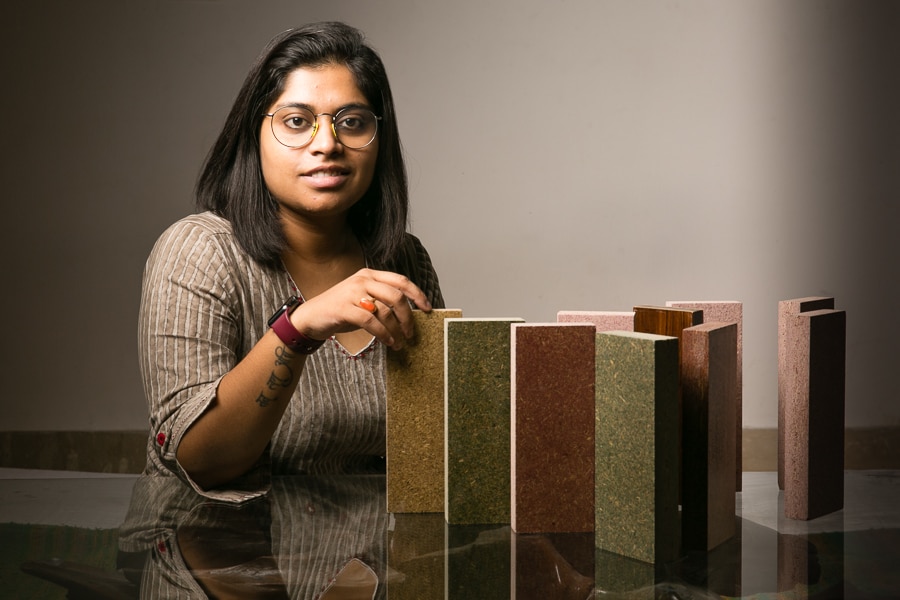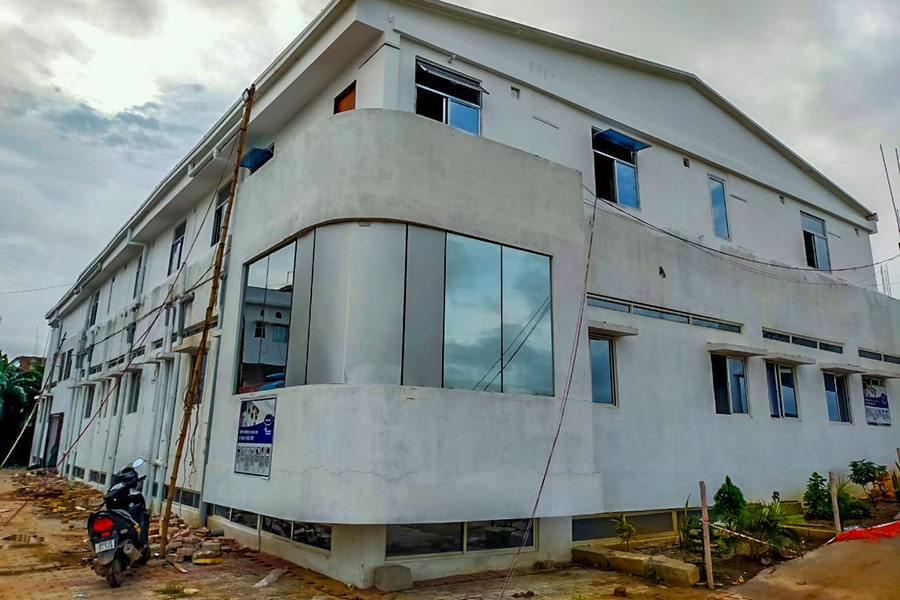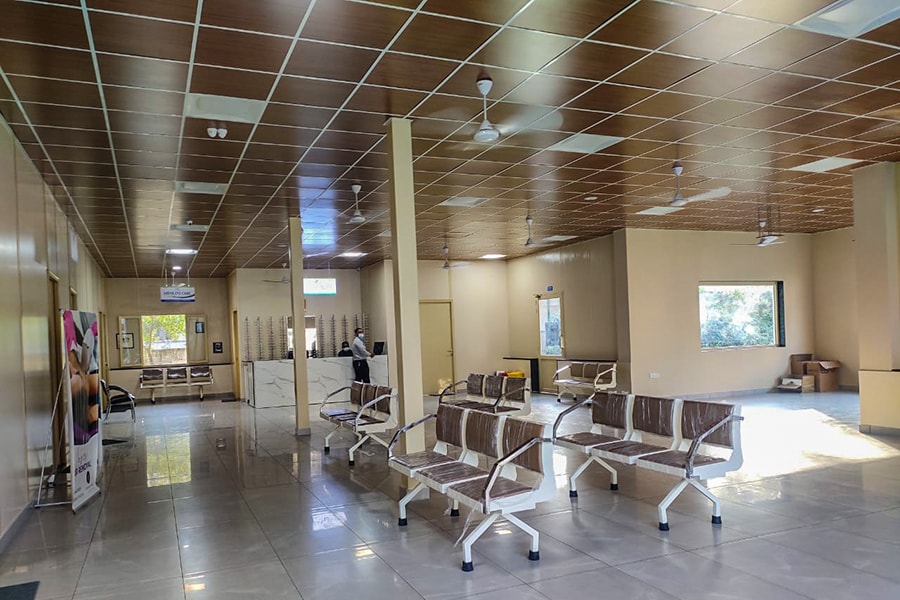This entrepreneur is building Covid care hospitals in rural areas of North India
Shriti Pandey, 29, is helping construct health care facilities at a faster pace in remote locations using sustainable materials derived from agricultural waste


 Shriti Pandey, founder, Strawcture Eco with the agri bio panels Image: Madhu Kapparath[br]
Shriti Pandey, founder, Strawcture Eco with the agri bio panels Image: Madhu Kapparath[br]
On July 11 last year, Shriti Pandey stood in front of Vistex Hospital—a Covid-19 hospital—in Masahri Block, Patna, watching its inauguration ceremony. "It took a village, quite literally, to build this hospital," recalls the 29-year-old. Along with her team and residents of the village, Pandey had set up the hospital in under 80 days using a sustainable material—agri bio panels—manufactured by her for-profit venture Strawcture Eco.
"The very next day, patients started coming. It was like they wanted the hospital built yesterday. In the 100 km stretch from Patna to the village, this was the first hospital that was built," she explains. The hospital was made for Doctors For You, a Delhi-based NGO, along with Selco Foundation. Currently, it can accommodate close to 100 beds and has about 11 to 12 doctors. With the situation getting dire in rural India, Doctors For You—the organisation running the hospital—has reached out to Pandey"s team to set up another 100-bed hall in order to accommodate more patients.
Her team knew time was less, so they worked simultaneously on many things. "For instance, while the foundation was being built, we did all the prefabrication in the field. So instead of individually connecting things, we made walls, roof and floors off site, like a modular construction," explains Pandey. These were brought to the site to simply connect, once the foundation was ready.

Vistex Hospital in Patna, Bihar, was built last year in June 2020 for Covid-19 patients. The first floor was built using Strawcture"s panels and frame
It was not just good coordination and planning, but also the agri bio panels in itself, that made things a lot faster for them. "With steel, as opposed to concrete, there is no drying period of 20 days. You can keep building. Similarly, our panels are 13 feet by 6 feet versus a brick that is 10 cm by 10 cm in size. The carpenters can work a lot faster with big panels. We would have put up a wall area of 40,000 sq feet in close to two to three weeks."
While the hospital was ready in under 80 days, there were challenges. Working 100 km away from the city with no electricity, about 60-70 percent of the work was done before getting to the site. "We had to rent a generator from a marriage hall, whose business was on a complete shutdown," says Pandey. Plus, they were working at a time when there was a complete lockdown.
While Pandey and her team are attempting to make the agri materials more affordable, currently the cost of the panel and steel frame versus brick and concrete is the same. "One of the reasons is that with our panel, there is no need for plaster. We directly paint. That makes it cheaper," she adds.
****
Pandey lived in Pandhana, Madhya Pradesh during her State Bank of India, Youth of India Fellowship between October 2016 and November 2017. During this time, she came across the issue of stubble burning. According to her, for any crop that is grown, 50 percent of its weight is a byproduct, which is stubble that has no use. India manufactures 500 million metric ton of stubble annually. "Often farmers—who have big land spaces—don"t have time to clear it [stubble] and end up burning it. No matter what government subsidy, unless there is a value attached to the straw and someone is willing to pay for it, they are not going to stop burning it," explains Pandey.
Given her background in civil engineering and construction management, she came up with the idea to convert stubble into a biomaterial. In June 2018, she set up Strawcture Eco where they manufacture the agri bio panels and also take up construction projects.
The biomaterial is locally manufactured using agri waste, and the look and feel is very similar to that of plywood. Traditionally, there are two things that go into building a house or hospital: brick and concrete. "In our case, the agri bio panel substitutes the brick part and the concrete is replaced by hollow steel frames, which can take the strength," she says.
****

The Batra Hospital in Jalandhar was built in January 2021 using Strawcture"s bio panels
In January 2021, Strawcture took up another project for Batra Hospital in Jalandhar, which took even lesser time—about 30 days. They were expanding their health care facilities to build a 6,000 square feet additional space to have more departments and specialisations. As the coronavirus crisis worsened, the entire hospital is now a Covid-19 hospital.
Pandey and her team have sent out proposals to collaborate with various state governments. In rural Uttar Pradesh, she is working on a project for a Covid hospital that is likely to start in the next month or two. Governments in Bihar and Jharkhand have asked for semi-temporary health care solutions in remote villages in their respective states. "The solutions we have offered this time will include proposals wherein these structures [hospitals] can be dismantled and using the same material, you can make smaller primary health care centres post the Covid-19 crisis," explains Pandey.
In December 2020, Strawcture also built a portable child care centre in Muzzafarpur, Bihar, a flood prone area. During the floods, it can be used as a shelter for people and then reused as a child care centre. Going forward, Pandey hopes to continue working both in rural and urban areas.
"‹
First Published: May 24, 2021, 15:39
Subscribe Now